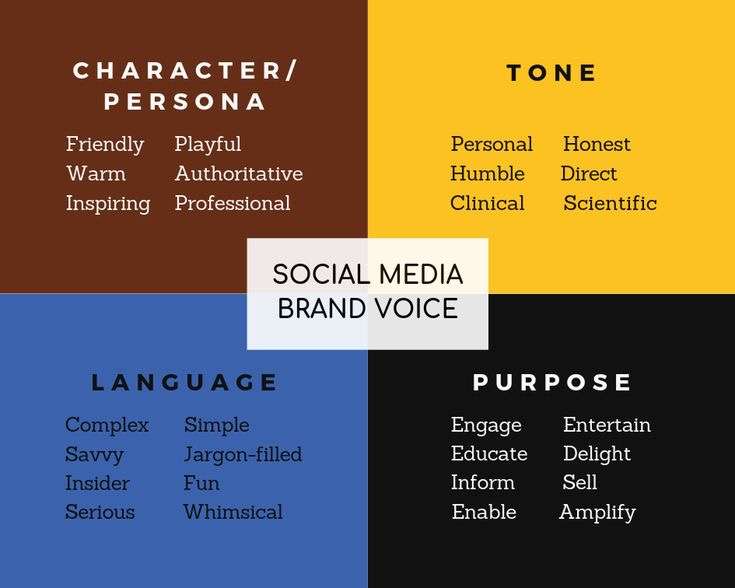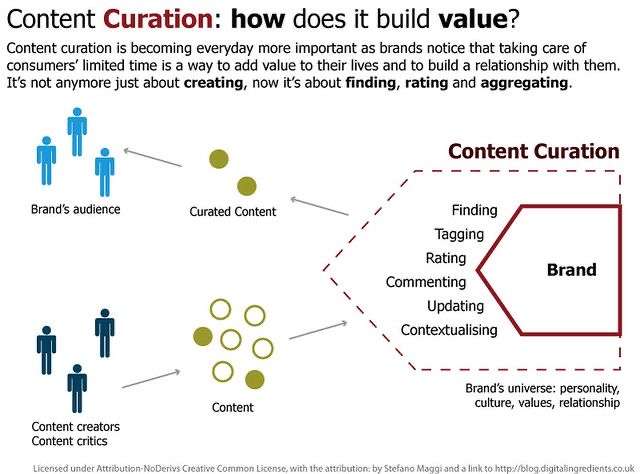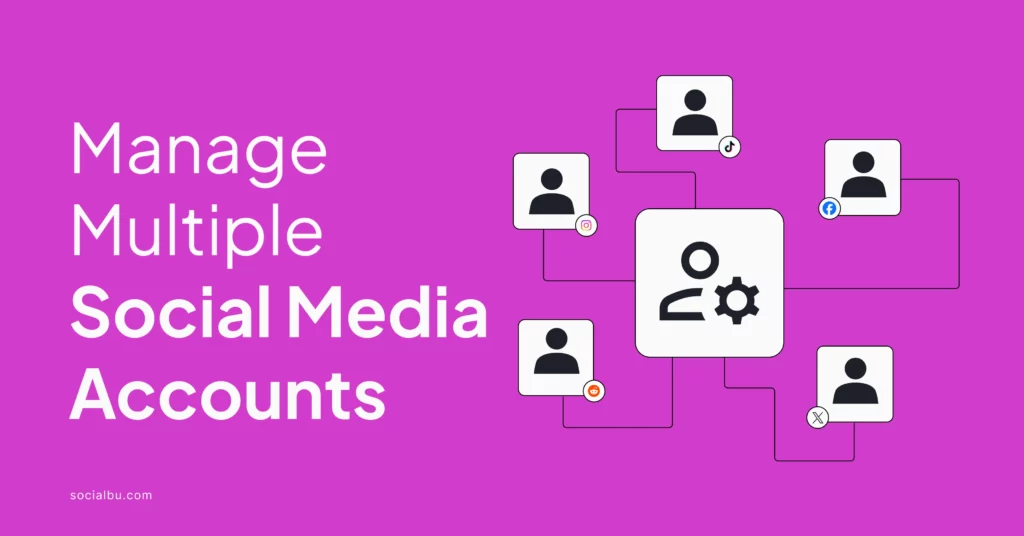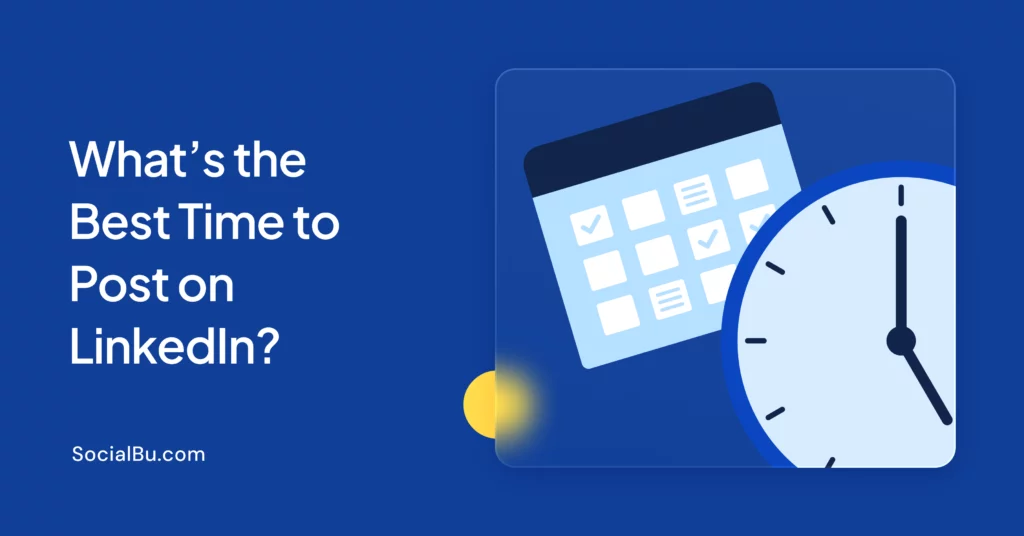Let’s face it – it is overwhelming to manage multiple social media accounts.
One minute you’re posting on Instagram, the next you’re replying to tweets, and suddenly you realize you haven’t updated your Facebook page in a week.
Sound familiar?
I’ve been there, and let me tell you, it’s not fun feeling like you’re always playing catch-up. But here’s the good news: it doesn’t have to be this way.
Over the years, I’ve picked up some tricks that have turned my social media chaos into a smooth-running machine.
And today, I’m going to spill the beans.
In this guide, we’re diving into the nitty-gritty of managing multiple social media accounts without losing your mind (or your social life).
Whether you’re a small business owner wearing all the hats, a social media manager juggling client accounts, or just someone trying to build their personal brand, I’ve got you covered.
How do you successfully manage multiple social media accounts?
Managing multiple social media accounts is no walk in the park, but with the right tools and strategies, it can be done.
Here are 9 tips I used to manage multiple social media accounts seamlessly:
1. Centralize your efforts
Let’s talk about getting organized. When you’re juggling multiple social media accounts, it’s easy to feel scattered. But here’s the thing – centralizing your efforts can make a world of difference.
Here’s how:
Use social media management tools
First up, let’s talk about social media management tools. These are absolute lifesavers when you’re dealing with multiple accounts. I remember when I first started using one – it felt like I’d discovered a secret weapon.
There are a ton of social media management tools out there, but I’ve found that SocialBu is honestly one of the best ones.
I’ve been using it for a while now and it’s been an absolute game-changer for how I handle my social media presence across multiple platforms.
The biggest thing for me is just how effortless it makes planning, automating, and organizing all my social posts.
I used to spend hours every week just trying to keep everything coordinated, but with SocialBu, I can get it all done in a fraction of the time.
And the best part is, the content still feels genuinely “me” – it’s not just some generic, cookie-cutter stuff.
With SocialBu, you can:
- Effortlessly plan, organize, and automate social posts across platforms
- Create stunning social media content using generative AI
- Monitor brand conversations in real-time with social listening
- Respond to messages across profiles with a unified inbox and auto-replies
- Streamline workflows by integrating RSS feeds and webhooks
The bottom line is, SocialBu just makes my whole social media workflow so much smoother and more efficient. I’m honestly not sure how I managed before.
If you’re looking for a comprehensive social media management solution, I’d highly recommend checking it out.
Make use of a content calendar
I used to think I didn’t need a Content Calendar, but man, was I wrong! Once I got one, I wished I had gotten it sooner.
A social media content calendar is a total game changer if you want to step up your social media game and make your life easier.
With a content calendar, you can easily meet deadlines and make sure you’re sharing different types of content across all your platforms. Plus, when everything is organized, it’s way less stressful.
Whether it’s a calendar template in Google Sheets, a social media management tool like Later, or a project management tool like Asana, a content calendar helps you stay organized and get things done efficiently.
I used to just wing it with my posting, but seriously, a content calendar has made all the difference.
Here’s what works for me:
1. I use Google Sheets, but use whatever you’re comfortable with.
2. I try to plan a week ahead. It takes some time, but it saves so much stress later.
3. I color-code everything. It might sound over the top, but it helps me see at a glance what’s going where.
4. I always leave some gaps for spur-of-the-moment stuff. You never know when something trending will pop up.
Your content calendar doesn’t have to be fancy. It just needs to work for you. The point is to know what you’re posting and when, across all your accounts.
Centralizing like this takes a bit of setup, but it’s worth it. You’ll feel more in control and less like you’re constantly playing catch-up.
2. Develop a consistent brand voice

When you’re managing multiple social media accounts, it’s easy to end up sounding like you have multiple personalities.
But here’s the thing – your followers should be able to recognize your brand no matter which platform they’re on.
Let’s talk about how to keep your voice consistent.
Nail down your brand guidelines
First things first – you need to know who you are as a brand. This might sound obvious, but you’d be surprised how many people skip this step.
Sit down and think about:
- What’s your brand’s personality? Are you formal or casual? Serious or funny?
- What kind of language do you use? Any specific words or phrases that are very “you”?
- What topics do you talk about? And just as importantly, what don’t you talk about?
Write this stuff down. It doesn’t have to be a fancy document – even a quick list on your phone can work.
The important thing is to have something you can refer back to when you’re not sure.
Adapting your content for each platform
Now, here’s where it gets tricky. Each social media platform has its own vibe, right? So you need to adapt your content without losing your brand voice.
It’s like speaking the same language with different accents.
Here’s how I approach it:
- Twitter: Keep it snappy and use hashtags, but make sure your brand personality shines through in those 280 characters.
- Instagram: It’s all about the visuals here. Your captions should match your image style – if your photos are sleek and minimalist, your words should be too.
- LinkedIn: You can be a bit more professional here, but don’t suddenly turn into a corporate robot if that’s not your brand.
- Facebook: This is a good middle ground. You can be a bit more casual and wordy than on other platforms.
The key is to adjust your tone slightly for each platform, but always stay true to your core brand voice.
It takes practice, but eventually, it’ll become second nature.
Remember, consistency doesn’t mean being boring. It means your followers always know it’s you, no matter where they find you.
It’s about building trust and recognition across all your social media accounts.
3. Prioritize platforms
Okay, let’s get real for a second. You don’t need to be everywhere all the time. In fact, trying to maintain a presence on every single social media platform out there is a recipe for burnout.
Trust me, I’ve been there. Here’s how you can do this;
Know where your people hang out
The first step is figuring out where your audience actually spends their time. It’s like throwing a party – you want to be where the cool kids are, right?
For example, if you’re targeting teens, TikTok might be your jam. But if you’re after business professionals, LinkedIn is probably where it’s at.
Instagram is great for visual content, while Twitter is perfect for quick updates and engaging in conversations.
Do some digging. Look at your current followers, check out where your competitors are active, and maybe even ask your audience directly.
You might be surprised at what you find out.
Focus on what works
Once you know where your audience is, it’s time to double down on those platforms. This doesn’t mean abandoning the others completely, but it does mean being smart about where you put most of your energy.
Here’s what I do:
1. I pick 2-3 main platforms to focus on. These get the bulk of my attention and original content.
2. For the others, I mostly cross-post or share when I have something really important to say.
3. I keep an eye on my analytics. If I see one platform start to pick up steam, I might shift my focus.
Remember, it’s better to do a great job on a few platforms than a mediocre job on all of them. Quality over quantity, always.
By prioritizing your platforms, you’ll save time, energy, and probably a good chunk of your sanity. Plus, you’ll likely see better results because you’re focusing on where your audience actually is. It’s a win-win.
4. Create and curate content strategically
Content is king, right? Well, when you’re managing multiple accounts, it can feel more like a demanding toddler.

Here’s how I’ve learned to keep up without losing my mind.
Mix it up
The secret to keeping your feeds fresh? A good mix of content. I aim for three types:
1. Original content: This is your bread and butter. It’s the stuff that shows off your brand’s personality. I try to create at least a few original pieces each week.
2. Curated content: Sharing other people’s content isn’t cheating – it’s smart. It fills your feed and shows you’re plugged into your industry. Just remember to add your own take when you share.
3. User-generated content: This is gold. When followers create content about your brand, it’s like free advertising. Plus, sharing it makes your audience feel appreciated.
The trick is finding the right balance. I usually go for 60% original, 30% curated, and 10% user-generated.
But play around and see what works for you.
Repurpose like a pro
Here’s a time-saving tip I wish I’d known earlier: Repurpose your content across platforms.
That blog post you wrote? Turn it into a series of tweets. That infographic? Slice it up for Instagram stories.
But here’s the catch – don’t just copy and paste. Each platform has its own vibe. A LinkedIn post shouldn’t sound like a TikTok caption.
Tweak your content to fit each platform’s style. For example, I might take a long-form article and:
- Pull out key stats for Twitter
- Create a summary graphic for Instagram
- Film a quick explainer video for TikTok
- Write a thoughtful reflection for LinkedIn
It takes a bit of creativity, but it beats starting from scratch every time.
Remember, creating content for multiple accounts doesn’t mean you need to make more content.
It’s about working smarter, not harder. Get strategic about what you create and how you use it, and you’ll save yourself a ton of time and stress.
5. Automate where possible
Okay, let’s talk about automation. It’s not about being lazy – it’s about working smarter, not harder.
You can start by;
Scheduling posts in advance
I used to spend hours every day posting to social media. Now? I batch my content and schedule it ahead of time. It’s been a huge time-saver.
Most of the management tools online have scheduling features. I usually sit down once a week, plan out my content, and schedule it all at once. It frees up so much time during the week.
A word of caution though – don’t just set it and forget it. You still need to keep an eye on things.
I learned this the hard way when I had a pre-scheduled post go out during a major news event. Not a good look.
Using chatbots for customer service
I was skeptical about using Chatbots at first, but they can be really helpful, especially for handling basic questions.
You can set up chatbots on platforms like Facebook Messenger to handle common queries. Things like business hours, pricing, or FAQs.
It’s like having a 24/7 customer service rep.
But remember, chatbots aren’t a complete replacement for human interaction. I use them to handle the simple stuff, which frees me up to personally deal with more complex issues.
Automation is great, but it’s a tool, not a solution. The goal is to free up your time so you can focus on the parts of social media management that really need the human touch.
For example, creating great content and building real connections with your audience.
Don’t go overboard with automation. You want your social media presence to feel authentic, not like it’s run by robots.
Find the right balance, and you’ll save time without losing that personal touch.
6. Engage authentically
Alright, let’s talk about one of the most important aspects of social media management engagement.
It’s not just about pushing out content, it’s about connecting with your audience.
You can connect more with your audience by:
Responding to comments and messages
I can’t stress this enough: respond to people. It’s called social media for a reason. When someone takes the time to comment or send a message, they’re reaching out to you.
Don’t leave them hanging.
Try to check your accounts a few times a day. I know it can feel overwhelming, especially when you’re managing multiple accounts, but it’s worth it.
Even a quick “Thanks for your comment!” can go a long way.
Pro tip: Use your management tool to set up notifications for comments and messages. That way, you’re not constantly checking each platform individually.
SocialBu helps you with that.
And here’s the thing, be real in your responses. People can smell a canned response from a mile away. Take a moment to actually read what they’ve said and respond thoughtfully.
It makes a huge difference.
Joining the conversation
Social media isn’t a one-way street. Don’t just wait for people to come to you, get out there and join conversations that are relevant to your brand or industry.
Follow hashtags related to your field. Join Facebook groups. Retweet and comment on posts that resonate with you. Share your thoughts on industry news or trends.
But remember, it’s not about selling all the time. Sometimes it’s just about being part of the community. Share your expertise, ask questions, be curious.
The more you genuinely engage, the more people will be drawn to your accounts.
I’ve found that setting aside a bit of time each day for this kind of engagement really pays off.
It helps you stay on top of what’s happening in your field, and it makes your social media presence feel more dynamic and alive.
Authentic engagement takes time and effort, but it’s what turns a social media account into a real community.
At the end of the day, that’s what makes managing multiple accounts worthwhile.
7. Monitor and analyze performance
Okay, let’s talk about the part that might make your eyes glaze over but is actually super important – monitoring and analyzing your performance.
I know, I know, numbers and graphs aren’t everyone’s cup of tea, but hear me out.
When I first started managing multiple accounts, I was flying blind. I’d post stuff and hope for the best. Big mistake.
Once I started actually looking at the numbers, it was like turning on a light in a dark room.
Each platform has its own metrics, but here are some I always keep an eye on:
- Engagement rate: Are people actually interacting with your posts?
- Reach: How many eyeballs are seeing your content?
- Follower growth: Are you gaining or losing followers?
- Click-through rate: If you’re sharing links, are people clicking?
Most social media management tools will give you these stats, or you can use each platform’s native analytics.
The key is to check regularly, I do a quick daily check and a deeper dive weekly.
Adjust strategies based on data insights
Here’s where the rubber meets the road. All those numbers? They’re telling you a story. Your job is to listen and adapt.
For example, I noticed that my LinkedIn posts were getting way more engagement when I posted in the morning, 8 a.m to be precise.
So I adjusted my schedule.
On Twitter, threads were outperforming single tweets, so I started doing more of those.
Don’t be afraid to experiment. Try different types of content, post at different times, use different hashtags. Then watch the numbers and see what happens.
It’s like being a scientist, but for social media.
Remember, what works for one account might not work for another. That’s why monitoring each account separately is crucial. It takes time, but it’s worth it.
The beauty of this approach is that over time, you’ll get better at predicting what will work.
You’ll waste less time on stuff that doesn’t resonate with your audience and focus more on what does.
In the end, monitoring and analyzing your performance isn’t about getting perfect numbers. It’s about understanding your audience better and giving them more of what they want.
And when you do that, everyone wins.
8. Build a team or delegate
This might seem a bit over the top, but there comes a point when you just can’t do it all yourself anymore.
You’re juggling accounts, your to-do list is a mile long, and you’re starting to dream in hashtags.
That’s when you know it’s time to think about building a team or delegating.
Assigning roles and responsibilities
If you’re in a position to build a team, even a small one, it can make a huge difference.
Here’s what I’ve learned about dividing up the work:
1. Play to people’s strengths. Maybe someone on your team is a Pro with graphics – put them in charge of visual content. Got a copywriter? Let them handle the captions and tweets.
2. Be clear about who’s doing what. There’s nothing worse than thinking someone else has posted that important update, only to find out they thought you were doing it.
3. Set up a system for communication. Whether it’s regular check-ins or a shared workspace like Slack, make sure everyone’s on the same page.
SocialBu offers a collaborative workspace where you and your team can work together on your social media content.
You can create, edit, and finalize content right in the app.
It’s super helpful for getting stuff done and making social media management easier.
4. Don’t forget about cross-training. It’s great to have specialists, but make sure more than one person knows how to do each task. You don’t want to be stuck if someone’s out sick.
Consider outsourcing or hiring specialists
Sometimes, bringing in outside help is the way to go. This could mean:
1. Hiring a freelance social media manager. They can take a lot off your plate, especially if you’re a small business owner trying to do it all.
2. Working with a social media agency. If you’ve got the budget, they can handle everything from strategy to daily posting.
3. Bringing in specialists for specific tasks. Maybe you need a graphic designer for your Instagram posts or a copywriter for your tweets.
4. Using virtual assistants for routine tasks. They can help with things like scheduling posts or moderating comments.
Remember, delegating doesn’t mean losing control. It’s about freeing up your time so you can focus on the big picture.
And let’s be honest, it’s also about maintaining your sanity.
Starting small is okay. Maybe you just delegate one platform or one type of task at first. The important thing is to recognize when you need help and not be afraid to ask for it.
Building a team or delegating might feel like a big step, but in my experience, it’s often the key to taking your social media presence to the next level.
Plus, it’s pretty great to have people to bounce ideas off of or to cover for you when you need a break.
9. Stay updated on platform changes
Social media platforms are always changing. It’s like they enjoy keeping us on our toes.
One day you’ve got the hang of things, and the next, there’s a new feature or algorithm update throwing you for a loop.
But don’t worry, staying in the know isn’t as hard as it seems.
Follow official sources
First things first, go straight to the source. Each platform has its own way of announcing updates:
- Facebook has its Newsroom
- Twitter broadcasts changes on their @TwitterSupport account
- Instagram often shares updates through their @Creators account
- LinkedIn has a blog where they post about new features
Follow these official channels. They’re your best bet for getting accurate, timely information about what’s changing and why.
But the truth is, who has time to constantly check all these sources? That’s where tech and social media news sites come in handy.
Places like TechCrunch, Social Media Today, or even good old Mashable often break down platform changes in easy-to-understand articles.
Adapt your strategy
Knowing about changes is one thing, but the real trick is adapting to them.
Here’s what I do:
1. Don’t panic. New features or algorithm changes might seem scary, but they’re often opportunities in disguise.
2. Test things out. When a new feature rolls out, play around with it. See how it fits into your strategy.
3. Watch what others do. Keep an eye on how other accounts in your industry react to changes. You might pick up some good ideas.
4. Be flexible. Sometimes, a change might mean rethinking your whole approach. That’s okay. Flexibility is key in social media.
5. Ask your audience. If you’re unsure about a new feature, why not ask your followers what they think? It’s a great way to engage and get valuable feedback.
Remember, staying updated isn’t about jumping on every new trend. It’s about understanding the changes and figuring out how they can work for you.
Sometimes, the best strategy is to wait and see how things shake out before making big moves.
The social media world is always changing, and that’s part of what makes it exciting.
By staying informed and adaptable, you’ll be ready to ride the waves of change instead of getting swept away by them.
Wrapping it up
So, we’ve covered a lot of ground here. Managing multiple social media accounts isn’t easy, but it’s definitely doable with the right approach.
Here’s the thing – there’s no one-size-fits-all solution. What works for one person might not work for another.
The key is to experiment, find what works for you, and be willing to adapt.
Remember, the goal isn’t to be everywhere all the time. It’s about connecting with your audience effectively, without burning yourself out in the process.
Social media should be a tool that works for you, not something that runs your life.
With these strategies, you can take control of your social media presence, save time, and maybe even enjoy the process a bit more.
So, take a deep breath. You’ve got this.
Start implementing these tips one by one, and before you know it, you’ll be managing multiple social media accounts like a pro.
FAQs
How do you successfully manage multiple social media accounts at once?
Successfully managing multiple social media accounts requires organization, efficiency, and the right tools. Here are some key strategies:
- Use a social media management platform like SocialBu to schedule posts and monitor engagement across multiple platforms.
- Create a content calendar to plan and organize your posts in advance.
- Tailor your content for each platform while maintaining a consistent brand voice.
- Set up a system for monitoring and responding to comments and messages across all accounts.
- Analyze performance metrics regularly to optimize your strategy for each platform.
What are three effective techniques for social media management?
1. Content Batching: Create content in bulk and schedule it in advance to save time and maintain consistency.
2. Engagement Automation: Use chatbots and automated responses for common inquiries to improve response times and free up resources for more complex interactions.
3. Cross-Platform Content Repurposing: Adapt and repurpose content across different social media platforms to maximize reach and efficiency.
How to become a better social media manager?
To improve your skills as a social media manager:
- Stay updated on platform changes and trending topics in your industry.
- Experiment with different content types and posting schedules to find what works best for your audience.
- Develop your analytical skills to interpret social media metrics and adjust your strategy accordingly.
- Enhance your creative abilities in areas like graphic design, copywriting, and video editing.
- Network with other social media professionals and learn from their experiences.
- Take online courses or attend workshops to expand your knowledge and skills.
What are the skills for social media management?
Essential skills for effective social media management include:
- Content Creation: Writing, graphic design, and video editing skills to produce engaging posts.
- Strategy Development: Ability to create and execute comprehensive social media plans.
- Analytics: Understanding and interpreting social media metrics to inform decision-making.
- Customer Service: Strong communication skills for interacting with followers and handling inquiries.
- Trend Awareness: Staying up-to-date with platform updates and industry trends.
- Time Management: Efficiently juggling multiple accounts and tasks.
- Adaptability: Quickly adjusting strategies based on performance and audience feedback.
- Basic Marketing Knowledge: Understanding principles of branding, audience targeting, and campaign management.







